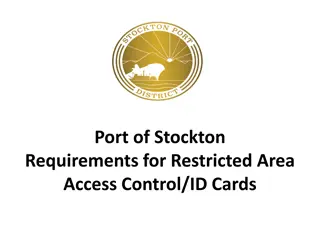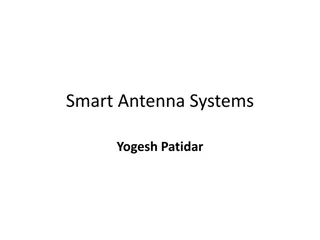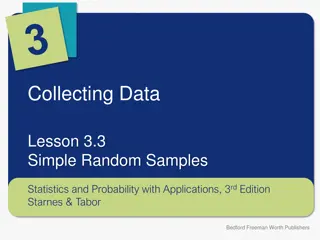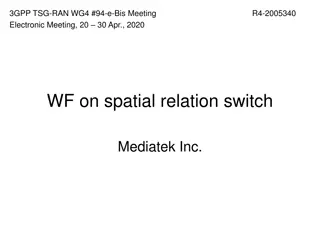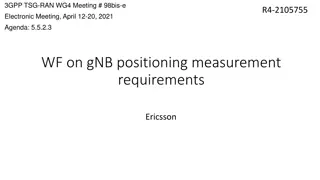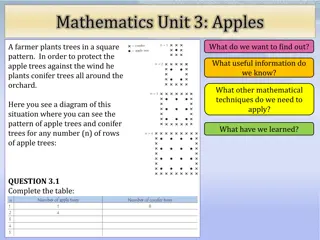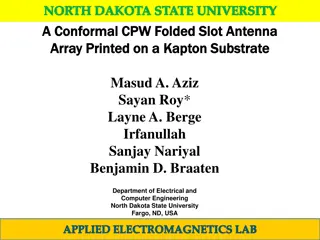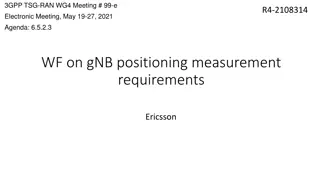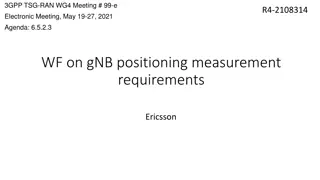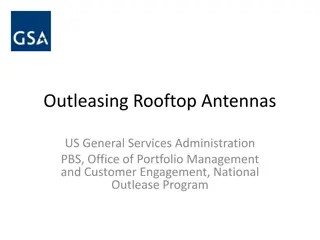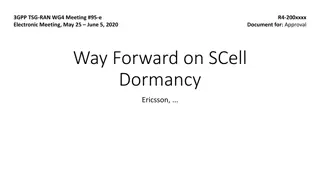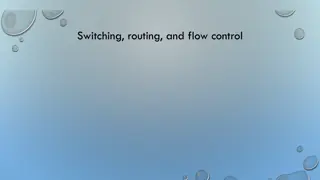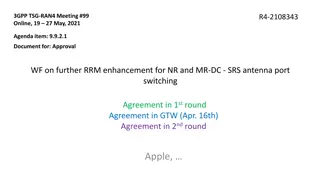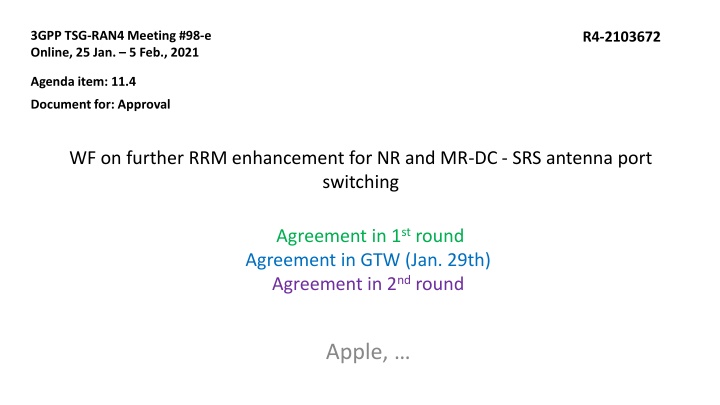
RRM Enhancement for NR and MR-DC: SRS Antenna Port Switching
Explore the requirements and impact of SRS antenna port switching in the context of RRM enhancement for NR and MR-DC. Delve into interruption, delay, and scope considerations in defining RRM requirements for SRS antenna port switching, with a focus on FR1 and FR2. Various stakeholders present different viewpoints on defining these requirements, emphasizing the importance of aligning with RF session conclusions.
Download Presentation

Please find below an Image/Link to download the presentation.
The content on the website is provided AS IS for your information and personal use only. It may not be sold, licensed, or shared on other websites without obtaining consent from the author. If you encounter any issues during the download, it is possible that the publisher has removed the file from their server.
You are allowed to download the files provided on this website for personal or commercial use, subject to the condition that they are used lawfully. All files are the property of their respective owners.
The content on the website is provided AS IS for your information and personal use only. It may not be sold, licensed, or shared on other websites without obtaining consent from the author.
E N D
Presentation Transcript
3GPP TSG-RAN4 Meeting #98-e Online, 25 Jan. 5 Feb., 2021 R4-2103672 Agenda item: 11.4 Document for: Approval WF on further RRM enhancement for NR and MR-DC - SRS antenna port switching Agreement in 1stround Agreement in GTW (Jan. 29th) Agreement in 2ndround Apple,
Sub-topic 1-1: Scope of SRS antenna switching requirement (1/2) Issue 1-1-1: whether interruption requirement would be defined in RRM for SRS antenna port switching Agreement: RAN4 to define interruption requirements for SRS antenna port switching Issue 1-1-2: whether delay requirement would be defined in RRM for SRS antenna port switching FFS: Option 1 (Ericsson): RAN4 to define SRS antenna port switching delay requirement. Option 2 (OPPO, NEC, Apple, Xiaomi, Intel, CATT, QC, Huawei?): No need to define SRS antenna port switching delay requirement in RRM. Option 3 (Ericsson, MTK, Nokia): FFS: whether delay requirement would be defined in RRM for SRS antenna port switching Agreements RRM delay requirement for SRS antenna port switching is FFS Option 1: Do not define SRS antenna port switching delay requirement in RRM. Option 2: Define SRS antenna port switching delay requirement same as RF retuning time. Option 3: Define SRS antenna port switching delay requirement. FFS for the value. At least RF retuning time shall be included. Issue 1-1-3: Impact of SRS antenna port switching to other RRM requirements FFS: Option 1 (Apple, Huawei, OPPO, NEC, Xiaomi, Intel, CATT, QC, MTK): Take the SRS carrier switching as the starting point to identify the impact on other RRM requirements. Option 2 (Ericsson): RAN4 to discuss the impact of SRS antenna port switching on timing measurements (e.g., UE Rx-Tx time difference, gNB Rx-Tx time difference, and UL RTOA measurements) and corresponding measurement requirements. Option 3 (Ericsson): Take the SRS carrier switching as the starting point to identify the impact on other RRM requirements. FFS: RAN4 to discuss the impact of SRS antenna port switching on timing measurements (e.g., UE Rx-Tx time difference, gNB Rx-Tx time difference, and UL RTOA measurements) and corresponding measurement requirements Option 4 (Nokia): FFS on whether take the SRS carrier switching as the starting point to identify the impact on other RRM requirements Agreements Further identify impact of SRS antenna port switching on RRM requirements, e.g. Timing measurements and corresponding measurement requirements Other RRM requirements
Sub-topic 1-1: Scope of SRS antenna switching requirement (2/2) Issue 1-1-4: RAN4 defines the requirement only for SRS antenna port switching in FR1 or in both FR1 and FR2 FFS: Option 1 (QC, OPPO): only SRS antenna port switching in FR1 is considered Option 2 (Apple, Xiaomi, MTK, Intel, NEC): SRS antenna port switching in FR1 and FR2 are considered Option 3 (Nokia, OPPO, Apple, LG, Xiaomi, vivo, Intel, CATT, QC, MTK): define the RRM requirements at SRS antenna switching only for FR1 unless the transient period in FR2 gets clarified in RF session (the scope of RRM requirements here depends on the conclusions from issue 1-1-1 and issue 1-1-2) Option 4 (Huawei): wait for the conclusion from RAN1 and RF Agreements Define the RRM requirements for SRS antenna port switching for FR1. FFS for FR2 SRS antenna port switching requirements: Further identify the applicability of the existing RF transient period for SRS antenna port switching.
Sub-topic 1-2: Interruption requirement applicability Issue 1-2-1: Interruption requirement applicability FFS: Option 1 (MTK, Huawei, OPPO, NEC, Xiaomi): The interruption requirement should base on the band combination capability reporting by UE. Option 2 (Huawei (observation 1), Nokia (proposal 5), NEC, Apple, vivo, CATT, QC): For the interruption cause by the switching period, whether the victim CCs are same as those indicated by the IEs (txSwitchImpactToRx or txSwitchWithAnotherBand) needs further discussion. Option 3 (Ericsson): Needs further checking and discussion. Issue 1-2-2: Victim cell type impacted by SRS antenna port switching Agreement: In the R17 FeRRM WI only RRM requirement of NR SRS antenna port switching would be discussed, including following cases (but all the victim CCs shall be determined by the conclusion in issue 1-2-1): NR SRS antenna port switching impacting LTE CC NR SRS antenna port switching impacting NR CC Issue 1-2-3: whether same interruption requirement applies to different SRS antenna port switching patterns FFS: Option 1 (vivo, OPPO, NEC, Apple, Xiaomi, Intel, CATT, QC): use same set of requirements for different SRS antenna switch patterns Option 2 (LGE): Depending on UE capability supportedSRS-TxPortSwitch, the interruption requirements should be defined. Option 3 (Ericsson, MTK, Nokia): further discussion is needed.
Sub-topic 1-3: Interruption requirement design (1/5) Issue 1-3-1: The interruption requirement is defined based on slot level or symbol level FFS: Option 1 (Apple, QC, MTK, Huawei, OPPO, Xiaomi, vivo, CATT): based on slot level Option 2 (LGE, NEC, Intel, Huawei, Ericsson): based on symbol level Option 3 (Nokia): FFS Issue 1-3-2: The components within interruption time of SRS antenna port switching in FR1 FFS: Option 1 (Xiaomi, MTK, vivo, Huawei, OPPO, LG, Intel, CATT): includes antenna switching time and SRS transmission time Option 1a (QC, NEC): includes antenna switching time and SRS transmission time; and transient periods before and after SRS transmission slot have to be taken into consideration. Option 1b (Ericsson): includes antenna switching time and SRS transmission time; and other components can be further discussed. Option 2 (Ericsson): FFS on followings FFS: time to switch to transmit, FFS: time to switch back, FFS: guard symbol(s), FFS: SRS transmission. Option 3 (Apple, Nokia): only antenna switching time If the transient period (15us) can be captured within the guard period in FR1, the UL interruption at SRS antenna switching shall be defined based on the minimum guard period specified in RAN1
Sub-topic 1-3: Interruption requirement design (2/5) Issue 1-3-3: if option 1 is adopted in issue 1-3-2, details of the interruption time in FR1 FFS: Option 1 (NEC, LG,): Interruption time for SRS antenna port switching when the SRS resource transmission in the SRS resource set is in same slot is (nrofSymbols+2+Y) OFDM symbols. Where nrofSymbolsis the number of SRS symbols in the SRS transmission during SRS antenna switching and Y is the minimum guard period between two SRS resources of an SRS resource set for antenna switching. Interruption time due to SRS antenna port switching when the SRS resources in a resource set are not in same slot are (nrofSymbols+2) OFDM symbols. Where nrofSymbolsis the number of SRS symbols in the SRS transmission during SRS antenna switching. Option 2 (MTK, OPPO, CATT): The SRS antenna switching interruption time should be (A) SRS Transmission time (up to 6 symbols). (B) 2 * 15us (The SRS antenna switching time is 15us) Option 3 (Xiaomi, Apple, vivo, MTK, Nokia): Wait the conclusion from issue 1-3-2 Option 4 (QC): SRS transmission time (up to 7 symbols) + 10us*2 transient period Issue 1-3-4: The components within interruption time of SRS antenna port switching in FR2 FFS: Option 1 (Xiaomi): The total interruption time of SRS antenna switching for MPUE would comprise of panel switching time, panel activation time and SRS transmission time. Option 2 (Intel): Clarify that current SRS antenna switching time of 15us is applied for FR2 case where SRS antenna switch in the same panel. For the case that SRS antenna switching happens between different panels for FR2, it needs further discussion whether extra ramp up timing for other antennas are needed. Option 3 (MTK (proposal 3)): includes antenna switching time and SRS transmission time. Option 4 (OPPO, NEC, Apple, Xiaomi, vivo, Intel, CATT, QC, MTK, Nokia): Wait the conclusion from issue 1-1-4
Sub-topic 1-3: Interruption requirement design (3/5) Issue 1-3-5: Would the interruption requirement based on different SCS? FFS: Option 1 (Apple, Huawei): Interruption requirement is based on the victim CC SCS. Option 2 (QC, MTK, vivo, OPPO, LG, Intel, CATT): Interruption requirement is based on the aggressor CC and victim CC SCS. Option 3 (Ericsson, Apple, Xiaomi): The interruption requirement depends at least on the SCS of the victim cell. FFS: the interruption requirement depends on the SCS of aggressor cell. Issue 1-3-6: Would the interruption requirement differentiate between sync and async cases? FFS: Option 1 (Apple, QC, MTK, OPPO, Xiaomi): No; based on the async case for the minimum requirement. Option 2 (LGE, CATT, Ericsson): Yes. Option 3 (Huawei, Nokia?): depends on whether to have slot level interruption or symbol level interruption. Need FFS. Issue 1-3-7: Interruption requirement for UE with or without per-FR MG capability FFS: Option 1 (Apple): For UE capable of per-FR MG, the interruption is only allowed to a victim serving CC if NR SRS antenna port switching happens in the same FR as this victim serving CC. For UE not capable of per-FR MG, the interruption is always allowed to a victim serving CC regardless of whether NR SRS antenna port switching happens in the same FR as this victim serving CC. Option 2 (MTK, Huawei, Xiaomi, CATT): No need to define the UE (not) capable of per-FR gaps requirement for SRS antenna port switching in RAN4. Option 3 (OPPO, QC, Ericsson, Nokia): FFS after addressing other issues
Sub-topic 1-3: Interruption requirement design (4/5) Issue 1-3-8: Interruption requirement proposals FFS: Option 1 (Apple): if NR SRS antenna switching causes interruption to LTE serving CC, the interruption is 2 subframes; while if NR SRS antenna switching causes interruption to NR serving CC, the interruption is 2 slots based on the SCS of the victim CC. Option 2 (QC, OPPO): SRS antenna switch interruption is specified as the following table for NR SA. In EN-DC, interruption on LTE carrier is the same as victim SCS = 15kHz case in NR SA. Interruption Length (slots) Victim SCS (kHz) 15 30 60 15 2 2 2 30 3 2 2 60 4 3 2 Option 3 (MTK): The SRS antenna switching interruption requirement is shown as follow. Victim cell SCS(KHz) 15 30 60 120 Aggressor Cell SCS (KHz) 30 2 2 2 3 15 2 2 3 5 60 2 2 2 3 120 2 2 2 2
Sub-topic 1-3: Interruption requirement design (5/5) (cont. from last slide) Issue 1-3-8: Interruption requirement proposals FFS: Option 4 (Intel): 1 additional OFDM symbol shall be added to the impacted DL interruption. The interruption length is 2 symbols for SCS=15KHz/30KHz/60KHz case and 3 symbols for SCS=120KHz case. Option 5 (NEC): Interruption time for SRS antenna port switching when the SRS resource transmission in the SRS resource set is in same slot is (nrofSymbols+2+Y) OFDM symbols. Where nrofSymbols is the number of SRS symbols in the SRS transmission during SRS antenna switching and Y is the minimum guard period between two SRS resources of an SRS resource set for antenna switching. Interruption time due to SRS antenna port switching when the SRS resources in a resource set are not in same slot are (nrofSymbols +2) OFDM symbols. Where nrofSymbols is the number of SRS symbols in the SRS transmission during SRS antenna switching. Option 6 (Apple, Xiaomi, vivo, Intel, CATT, QC, Ericsson, MTK, Nokia, LG): Need to wait for the conclusions from previous issues
Sub-topic 1-4: LS to RAN1 for clarification Issue 1-4: LS to RAN1 FFS: Option 1 (Nokia): Send LS to RAN1 clarifying the following questions on the applicability of guard period: Does the guard period apply only if the SRS resources of a set are transmitted in the same slot i.e., if it applies if SRS resources of a set are transmitted in different slots? Does the guard period apply in the case of non-consecutive SRS switching i.e. if the SRS resources of a set are separated by more than one OFDM symbols in FR1?


